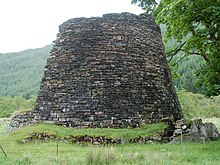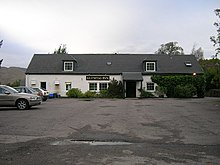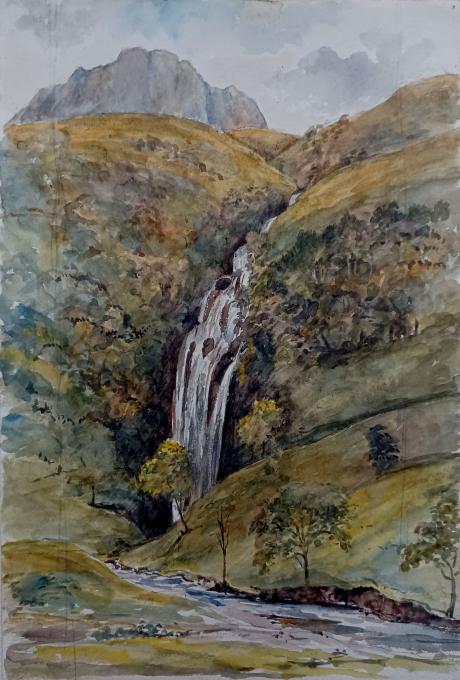inscribed and sigend with initials "Glenelg Waterfall /LWT"
Tom and Laura Taylor and thence by descent
Glenelg is a scattered community area and civil parish in the Lochalsh area of Highland in western Scotland. Despite the local government reorganisation the area is considered by many still to be in Inverness-shire, the boundary with Ross-shire (where the post town of Kyle of Lochalsh is situated) being at the top of Mam Ratagan ("Ratagan Gap" or "pass") the single-track road entry into Glenelg.
The main village is called Kirkton of Glenelg and commonly referred to as "Glenelg". There is a smaller hamlet less than one mile (two kilometres) to the south by the jetty and skirting Glenelg Bay known as Quarry. There are several other clusters of houses scattered over Glenelg including up Glen Beag and Glen More and on the road leading to the ferry at Kyle Rhea. The parish covers a large area including Knoydart, North Morar and the ferry port of Mallaig. At the 2001 census it had a population of 1,507. The smaller "settlement zone" around Kirkton had a population of 283. In 2011 Highland Council estimated that the community of Glenelg and Arnisdale had a population of 291.


Glenelg is located south of Loch Alsh, by the fiercely tidal Kyle Rhea narrows, where the Isle of Skye is closest to the mainland. Between November and February, the only access to Glenelg is by road over the 339-metre (1,112 ft) Mam Ratagan – known loosely as "the Bealach" (pass) – from Shiel Bridge on the main road from Inverness to Skye. From the summit of Mam Ratagan the road runs gently into Glenelg down Glen More (Gleann Mhòr, "big valley"), which is otherwise isolated from Loch Duich by Beinn a Chuirn, and from Loch Alsh by Glas Beinn. There is a second valley, approximately parallel to Glen More and to the south known as Glen Beag (Gleann Beag, "small valley"), separated from Glen More by Beinn a' Chaonich. On reaching the coast, the road continues southwards, following the shore of Loch Hourn, where it terminates at Corran; Loch Hourn is separated from Glen Beag by Beinn a' Chapuill and Beinn Sgritheall.
Its proximity to Skye meant that Glenelg was formerly of more strategic importance and had a significantly larger population. It appears on the relevant map of the first atlas of Scotland, published by Joan Blaeu in Amsterdam in 1662, for instance. Cattle from the outer islands were taken to Uig in the north of Skye to join with those reared on Skye and other nearby islands, driven south to the village of Kylerhea, and, tied together in dozens, nose ring to tail and guided by a rowing boat, swum the 534 metres to the mainland before being herded to market along the drovers' road through Glen Beag, on to Kinlochhourn and then to the markets at Stirling and Falkirk and elsewhere in the Scottish Lowlands. Between March and October, there is the option to cross the Kyle Rhea strait by ferry (see below).
Following the Jacobite rising of 1715, Glenelg was chosen along with Fort George, Fort Augustus and Fort William as one of four sites in the Highlands for a military barracks. These were completed in 1725 and a military road soon linked Glenelg to the rest of General George Wade's road network. Ultimately unsuccessful in preventing the 1745 uprising and not needed after the Highland Clearances, the Bernera Barracks are now ruined.
The war memorial in Glenelg was erected in 1920 to a design by Sir Robert Lorimer.

A person from Glenelg is known in Gaelic as an Eilgeach.

Between March and October, a small vehicle ferry connects to Kylerhea on Skye across the powerful currents of the narrows. The ferry used on the crossing since 1982 is the MV Glenachulish, the last hand-operated steel turntable ferry in operation in the world. Built in 1969 for the Ballachulish crossing by the Ailsa Shipbuilding Company in Troon, it is now operated by a local community-interest company. The ferry can transport six cars plus foot passengers on the open deck. It is unusual in that the ferry ties up alongside the slipway and the crew manually turn the deck, which is built on a turntable, for cars and passengers to embark and disembark. When the Ballachulish Bridge opened in 1975, it became the relief vessel for Corran, Kylesku and Kessock near Inverness. The ferry service was suspended in 2020 because of the COVID-19 pandemic but restarted on 1 May 2021.
The Glenelg Ferry slipway was designed by Thomas Telford in 1818 and is Category B listed.
The ferry is a tourist attraction in itself. Another attraction in recent years are a pair of resident sea eagles During the summer, sightings are almost daily as they fish by the ferry crossing trying to feed their young. Glenelg attracts tourists to the remains of two of the best-preserved brochs (Dun Telve and Dun Troddan) on mainland Scotland, located in Glen Beag.


The community's only pub is the Glenelg Inn. This stands on the site of the earlier Glenelg Hotel, a hotel with marble flooring which caught fire in 1946 and had to be demolished. There is also a village shop, an organic market garden/croft and associated cafe, in Glen Beag. There is also a seasonal cafe in the Glenelg Village Hall in Kirkton and local businesses offering local services including bicycle hire and repair.

Glenelg Parish Church of Scotland has an 18th-century core. It under went repairs from 1821 to 1830, the interior was remodelled in 1863 and again in 1929. There is an 18th-century bird-cage bellcote to the west gable.
Although the name nowadays refers to the whole district, it is likely that it originally referred only to the glen containing the brochs. The specific element of the name (Eilg) is found elsewhere, such as in Elgin (Gaelic Eilginn) and is generally accepted as being a kenning for Ireland. Other such names include Banavie, Banff, Atholl, Lochearn, Auldearn, and show Gaelic settlers using the same migrant naming practice as gives us placenames such as New Caledonia and New York.
The name is unusual in that it is a palindrome.
Glenelg was officially twinned with Glenelg, Mars, on 20 October 2012. A palindromic name was chosen by NASA because the rover Curiosity would visit the site twice.
The author Gavin Maxwell's retreat at Sandaig (which he called Camusfeàrna, "the bay of the alders", in his book Ring of Bright Water) is within the Glenelg community area around six miles (ten kilometres) south of Kirkton of Glenelg. The house had previously been a smallholding and home for the part-time lighthouse keeper of the Sandaig Lighthouse.
The Sandaig Light formerly on Little Sandaig was built in 1910 by Charles Alexander Stevenson (cousin of the novelist Robert Louis Stevenson) for the Northern Lighthouse Board. In 2002 the tower was restored and moved to the community-owned Glenelg Ferry Terminal where it is now a feature.
The eponymous Sandaig Islands are a small group of islets just off the point in the Sound of Sleat and are known for their fine silvery shell sand beaches.
Sandaig can be accessed by foot from the main Glenelg to Arnisdale Road.
- Alasdair Mac Mhaighstir Alasdair, (1698-1770) legendary Scottish Gaelic poet, officer during the Jacobite Uprising of 1745, and Gaelic tutor to Prince Charles Edward Stuart spent his last years at Sandaig
- Terry Nutkins, (1946-2012) naturalist, television presenter and author, and in his youth was one of Gavin Maxwell's otter keepers.
- Neil M. Gunn, novelist, spent holidays with his sister Mary and her husband Dr Keillor who was the local GP, and regarded it as his second home.
- Gavin Maxwell, (1914–1969) was a Scottish naturalist and author, best known for Ring of Bright Water (1960), his account of his life at Sandaig with his pet otter Mijbil.
- (Frederick) Anthony Hamilton Wills, 2nd Baron Dulverton (1915–1992) owner of Eilanreach Estate on which Sandaig is situated.
- Dr Samuel Johnson and James Boswell stayed at the inn now known as Ferry House, on their tour of the Highlands in 1773 later published as Journey to the Western Isles of Scotland (1775).
Laura Wilson Barker (6 March 1819 – 22 May 1905), was a composer, performer and artist, sometimes also referred to as Laura Barker, Laura W Taylor or "Mrs Tom Taylor".
She was born in Thirkleby, North Yorkshire, third daughter of a clergyman, the Rev. Thomas Barker. She studied privately with Cipriani Potter and became an accomplished pianist and violinist. As a young girl Barker performed with both Louis Spohr and Paganini. She began composing in the mid-1830s - her Seven Romances for voice and guitar were published in 1837. From around 1843 until 1855 she taught music at York School for the Blind. During this period some of her compositions - including a symphony in manuscript, on 19 April 1845 - were performed at York Choral Society concerts.
On 19 June 1855 she married the English dramatist, critic, biographer, public servant, and editor of Punch magazine Tom Taylor. Barker contributed music to at least one of her husband's plays, an overture and entr'acte to Joan of Arc (1871), and provided harmonisations as an appendix to his translation of Ballads and Songs of Brittany (1865).
Her other works include the cantata Enone (1850), the violin sonata A Country Walk (1860), theatre music for As You Like It, (April 1880), Songs of Youth (1884), string quartets, madrigals and solo songs. Her choral setting of Keats's A Prophecy, composed in 1850, was performed for the first time 49 years later at the Hovingham Festival in 1899. The composer was present.
Several of Barker's paintings hang at Smallhythe Place in Kent, Ellen Terry's house.
Barker lived with her husband and family at 84 Lavender Sweep, Battersea. There were two children: the artist John Wycliffe Taylor (1859–1925), and Laura Lucy Arnold Taylor (1863–1940). The Sunday musical soirees at the house attracted many well-known attendees, including Lewis Carroll, Charles Dickens, Henry Irving, Charles Reade, Alfred Tennyson, Ellen Terry and William Makepeace Thackeray.
Tom Taylor died suddenly at his home in 1880 at the age of 62. After his death, his widow retired to Porch House, Coleshill in Buckinghamshire, where she died on 22 May 1905, aged 86.

